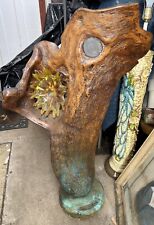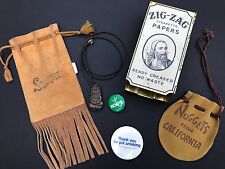1960s Hippie PEYOTE Psychedelic Marijuana Pot LSD Acid Protest Cause Peace Pin

When you click on links to various merchants on this site and make a purchase, this can result in this site earning a commission. Affiliate programs and affiliations include, but are not limited to, the eBay Partner Network.
1960s Hippie PEYOTE Psychedelic Marijuana Pot LSD Acid Protest Cause Peace Pin:
$24.95
THIS IS A 1 NCH CELLULOID PINBACK BUTTON IN WHAT I BELIEVE TO BE REALLY GREAT SHAPE HOWEVER, THAT IS ONLY MY OPINION: SEE PHOTOS OF FRONT AND BACK FOR CONDITION, AND YOU BE THE JUDGE.
IF YOU HAVE ANY QUESTIONS, PLEASE CONTACT ME BEFORE offerDING OR BUYING.
RETURNS ARE NOT ACCEPTED UNLESS THE ITEM HAS SIGNIFICANT DAMAGE OR DEFECTS NOT VISIBLE IN THE PHOTOS OR OTHERWISE DESCRIBED.
GUARANTEED AUTHENTIC AND ORIGINAL AS DESCRIBED.
This pin was sold in the mid 1960\'s, promoting the counterculture, use of psychedelic drugs (such as Peyote, Psyscilibin cPot, Grass, Weed, Mary Jane, Marijuana, Hash, LSD, ACID, Peyote, Magic Mushrooms, psilocybin, mescaline, MDMA, STP, Speed, etc.) and the hippie free love lifestyle. This and other counterculture pins were sold at poster shops, Head Shops, music shows and concerts, record stores, book stores, comic book stores, news stands, on the streets, in the parks (at love in\'s), etc.
The pin reads PEYOTE.
Peyote a cactus plant, contains the psychoactive drug mescaline, known for its hallucinogenic effects comparable to those of LSD and psilocybin.
Peyote had been used for at least 5,700 years by Native Americans in Mexico. Europeans noted use of peyote in Native American religious ceremonies upon early contact, notably by the Huichols in Mexico. Other mescaline-containing cacti such as the San Pedro have a long history of use in South America, from Peru to Ecuador.In traditional peyote preparations, the top of the cactus is cut off, leaving the large tap root along with a ring of green photosynthesizing area to grow new heads. These heads are then dried to make disc-shaped buttons. Buttons are chewed to produce the effects or soaked in water to drink.
However, the taste of the cactus is bitter, so contemporary users will often grind it into a powder and pour it in capsules to avoid having to taste it. The usual human dosage is 200–400 milligrams of mescaline sulfate or 178–356 milligrams of mescaline hydrochloride. The average 76 mm (3.0 in) button contains about 25 mg mescaline.
This underground pinback button pin or badge relates to the Hippie (or Hippy) Counterculture Movement of the psychedelic Sixties (1960\'s) and Seventies (1970\'s). That movement included such themes and topics as the Black Panthers, peace, protest, civil rights, radical, socialist, communist, anarchist, union labor strikes, drugs, marijuana, pot, weed, lsd, acid, sds, iww, anti draft, anti war, anti rotc, welfare rights, poverty, equal rights, integration, gay, women\'s rights, black panthers, black power, left wing, liberal, etc. progressive political movement
The Deacons emerged as one of the first visible self-defense forces in the South and as such represented a new face of the civil rights movement. Traditional civil rights organizations remained silent on them or repudiated their activities. They were effective however in providing protection for local African Americans who sought to register to vote and for white and black civil rights workers in the area. The Deacons, for example, provided security for the 1966 March Against Fear from Memphis to Jackson, Mississippi. Moreover their presence in SouthEastern Louisiana meant that the Klan would no longer be able to intimidate and terrorize local African Americans without challenge. The strategy and methods that the Deacons employed attracted the attention and concern of the Federal Bureau of Investigation (FBI), which authorized an investigation into the group’s activities. The investigation stalled, however, when more influential black power organizations such as US and the Black Panther Party emerged after the 1965 Watts Riot. With public attention, and the attention of the FBI focused elsewhere, the Deacons lost most of their notoriety and slowly declined in influence. By 1968 they were all but extinct. In 2003 the activities of the Deacons was the subject of a 2003, “Deacons for Defense.” - See more at: July 10, 1964, a group of African American men in Jonesboro, Louisiana led by Earnest “Chilly Willy” Thomas and Frederick Douglas Kirkpatrick founded the group known as The Deacons for Defense and Justice to protect members of the Congress of Racial Equality (CORE) against Ku Klux Klan violence. Most of the “Deacons” were veterans of World War II and the Korean War. The Jonesboro chapter organized its first affiliate chapter in nearby Bogalusa, Louisiana led by Charles Sims, A.Z. Young and Robert Hicks. Eventually they organized a third chapter in Louisiana. The Deacons tense confrontation with the Klan in Bogalusa was crucial in forcing the federal government to intervene on behalf of the local African American community. The national attention they garnered also persuaded state and national officials to initiate efforts to neutralize the Klan in that area of the Deep South. The Deacons emerged as one of the first visible self-defense forces in the South and as such represented a new face of the civil rights movement. Traditional civil rights organizations remained silent on them or repudiated their activities. They were effective however in providing protection for local African Americans who sought to register to vote and for white and black civil rights workers in the area. The Deacons, for example, provided security for the 1966 March Against Fear from Memphis to Jackson, Mississippi. Moreover their presence in SouthEastern Louisiana meant that the Klan would no longer be able to intimidate and terrorize local African Americans without challenge. The strategy and methods that the Deacons employed attracted the attention and concern of the Federal Bureau of Investigation (FBI), which authorized an investigation into the group’s activities. The investigation stalled, however, when more influential black power organizations such as US and the Black Panther Party emerged after the 1965 Watts Riot. With public attention, and the attention of the FBI focused elsewhere, the Deacons lost most of their notoriety and slowly declined in influence. By 1968 they were all but extinct. In 2003 the activities of the Deacons was the subject of a 2003, “Deacons for Defense.” - See more at: July 10, 1964, a group of African American men in Jonesboro, Louisiana led by Earnest “Chilly Willy” Thomas and Frederick Douglas Kirkpatrick founded the group known as The Deacons for Defense and Justice to protect members of the Congress of Racial Equality (CORE) against Ku Klux Klan violence. Most of the “Deacons” were veterans of World War II and the Korean War. The Jonesboro chapter organized its first affiliate chapter in nearby Bogalusa, Louisiana led by Charles Sims, A.Z. Young and Robert Hicks. Eventually they organized a third chapter in Louisiana. The Deacons tense confrontation with the Klan in Bogalusa was crucial in forcing the federal government to intervene on behalf of the local African American community. The national attention they garnered also persuaded state and national officials to initiate efforts to neutralize the Klan in that area of the Deep South. The Deacons emerged as one of the first visible self-defense forces in the South and as such represented a new face of the civil rights movement. Traditional civil rights organizations remained silent on them or repudiated their activities. They were effective however in providing protection for local African Americans who sought to register to vote and for white and black civil rights workers in the area. The Deacons, for example, provided security for the 1966 March Against Fear from Memphis to Jackson, Mississippi. Moreover their presence in SouthEastern Louisiana meant that the Klan would no longer be able to intimidate and terrorize local African Americans without challenge. The strategy and methods that the Deacons employed attracted the attention and concern of the Federal Bureau of Investigation (FBI), which authorized an investigation into the group’s activities. The investigation stalled, however, when more influential black power organizations such as US and the Black Panther Party emerged after the 1965 Watts Riot. With public attention, and the attention of the FBI focused elsewhere, the Deacons lost most of their notoriety and slowly declined in influence. By 1968 they were all but extinct. In 2003 the activities of the Deacons was the subject of a 2003, “Deacons for Defense.” - See more at: July 10, 1964, a group of African American men in Jonesboro, Louisiana led by Earnest “Chilly Willy” Thomas and Frederick Douglas Kirkpatrick founded the group known as The Deacons for Defense and Justice to protect members of the Congress of Racial Equality (CORE) against Ku Klux Klan violence. Most of the “Deacons” were veterans of World War II and the Korean War. The Jonesboro chapter organized its first affiliate chapter in nearby Bogalusa, Louisiana led by Charles Sims, A.Z. Young and Robert Hicks. Eventually they organized a third chapter in Louisiana. The Deacons tense confrontation with the Klan in Bogalusa was crucial in forcing the federal government to intervene on behalf of the local African American community. The national attention they garnered also persuaded state and national officials to initiate efforts to neutralize the Klan in that area of the Deep South. - See more at: IS MY HOBBY AND IS NOT A BUSINESS. THIS AND MY OTHER ITEMS ON ARE FROM MY PERSONAL COLLECTIONS AND WERE NOT INITIALLY ACQUIRED BY ME FOR RESALE. PROCEEDS GO TO BUY OTHER STUFF I AM INTERESTED IN COLLECTING.I AM A MEMBER OF A. P. I .C. (AMERICAN POLITICAL ITEMS COLLECTORS). IF YOU ARE NOT A MEMBER, YOU SHOULD CONSIDER JOINING. IT IS AGREAT ORGANIZATION!
SHIPPING: ITEMS WILL BE SAFELY PACKED TO AVOID DAMAGE DURING SHIPPING. ITEMS ARE SHIPPED BY FIRST CLASS MAIL, ITEMS ARE SHIPPED WITHIN A BUSINESS DAY OR TWO OF RECEIPT OF PAYMENT.
I WILL REDUCE SHIPPING CHARGES ON MULTIPLE ITEMS. For each additional item, add $ .50 (fifty cents). ALL I ASK IS THAT YOU LET ME KNOW YOU WOULD LIKE A COMBINED SHIPPING PRICE BEFORE PAYING SO I CAN INVOICE YOU WITH THE REDUCED SHIPPING COSTS.
SHIPPING TO DESTINATIONS WITHIN THE UNITED STATES BY FIRST CLASS MAIL IS $3.50. IF YOU WOULD LIKE YOUR ITEMS SENT BY PRIORITY MAIL INSTEAD, PLEASE LET ME KNOW BEFORE PAYING SO I CAN SEND YOU AN INVOICE FOR THE INCREASED AMOUNT.
OUTSIDE THE UNITED STATES, SHIPPING IS $15.00 FOR FIRST CLASS MAIL. IF YOU WOULD LIKE YOUR ITEMS SENT BY INTERNATIONAL PRIORITY MAIL INSTEAD, PLEASE LET ME KNOW BEFORE PAYING, SO I CAN SEND YOU AN INVOICE FOR THE INCREASED AMOUNT (APPROX $30).
.
THANK YOU FOR YOUR INTEREST.
1960s Hippie PEYOTE Psychedelic Marijuana Pot LSD Acid Protest Cause Peace Pin:
$24.95

Related Items:
Vintage 5” T Boho Hippy Folk Art 60s Art Glass Wood Burl Floor Lamp SCULPTURE
$1800.00
Rare, Vintage HIPPIE MEMORABILIA CANNABIS COLLECTION Late 1960's - Early 1970's
$1500.00
KEITH ENGLISH '60s HIPPIE flower child mcm art painting vtg hollywood girl love
$1500.00







